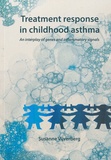Treatment response in childhood asthma
An interplay of genes and inflammatory signals

Vijverberg, Susanne
- Promoter:
- Prof.dr. J.A.M. (Jan) Raaijmakers & prof.dr. L. (Leo) Koenderman
- Co-promoter:
- Dr. A.H. (Anke) Maitland
- Research group:
- Koenderman
- Date:
- April 9, 2014
- Time:
- 14:30 h
Summary
Treatment response in asthmatic children Asthma is a chronic disease of the airways and the most common chronic disease among children. Inhaled corticosteroids (ICS) are the cornerstone of persistent asthma treatment and are thought to function due to their anti-inflammatory properties. Additionally, β2-adrenergic receptor agonists (short- or long-acting) are used to relieve asthma symptoms. Although asthma treatment is effective in many patients, there is large variability in the level of symptom control and lung function improvement. Furthermore, a small group of patients continues to suffer from severe exacerbations, or long-term uncontrolled asthma symptoms, despite asthma maintenance treatment. The thesis of Susanne Vijverberg describes research on the biological profile underlying asthma treatment outcomes in children. Research methodologies from the fields of pharmacoepidemiology, pharmacogenetics, immunology and breath metabolomics were applied to study asthma treatment response. Most studies have been performed in the context of the PACMAN cohort study, a Dutch pharmacy-based cohort study of children with a reported use of asthma medication. Main findings of this thesis The research in this thesis shows that various genetic loci influence the risk of severe exacerbations or poor symptom control in children with a reported use of asthma medication. Variation in the gene ST13 and in a DNA region called the 17q21 locus, were found to be associated with an increased risk of severe exacerbations despite ICS use. Variation in another gene, ADRB2, was found to be associated with a poorer response to long-acting β2-adrenergic receptor agonists. Especially this genetic marker seems to have a large effect on treatment response. Furthermore, the research shows that the pre-activation of granulocytes in the peripheral blood did not relate to asthma symptoms or lung function. Airway inflammation is one of the main pathological characteristics of asthma. Inflamed tissue releases chemo-attractants and cytokines which recruit activated immune cells, such as granulocytes, from the peripheral blood. It was hypothesized that the level of pre-activated granulocytes in peripheral blood would be different in children with uncontrolled asthma symptoms compared to children with controlled symptoms. However, no differences were found. Additionally, preliminary data in this thesis shows that breath analysis might be promising tool to identify distinct asthma phenotypes in a non-invasive manner. The measurement of a combination of exhaled inflammatory markers is more accurate in capturing the different aspects of asthma control than the measurement of one single exhaled inflammatory marker. Recommendations In the near future, clinically applicable algorithms incorporating genetic and inflammatory markers may help to diagnose and stratify treatment. The first steps towards this personalised treatment involve the identification and validation of potential biomarkers. A multi-dimensional biomarker approach (the assessment of a multitude of biomarkers), rather than a single biomarker-approach should be applied to characterize the different asthma phenotypes. In addition, there is a need for international collaboration to exchange knowledge, obtain larger study populations and validate biomarkers. Lastly, large randomised controlled trials are necessary to evaluate the clinical value of ADRB2-guided treatment in asthmatic children in comparison to current clinical practises.